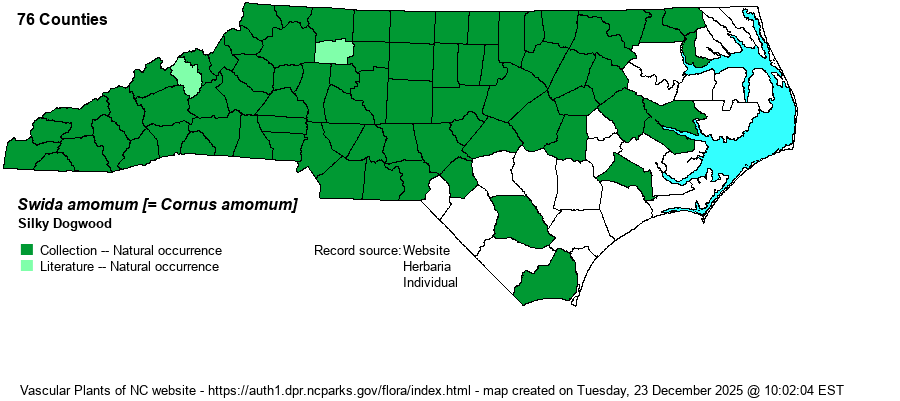| Author | (P. Miller) Small | |
| Distribution | Throughout the Mountains, Piedmont, and the western Coastal Plain. Widely scattered in the central and eastern Coastal Plain, but certainly absent in some counties, especially near the coast.
This species occurs over most of the eastern U.S., from ME south to the FL panhandle, and west to the Mississippi River. It is sporadic in occurrence in the Coastal Plain of the Southern states (NC southward).
| |
| Abundance | Frequent to common across the Mountains and Piedmont (probably more common in the Piedmont, as habitat is more widespread). Reasonably common in the western Coastal Plain, but rare to uncommon in the northern Coastal Plain and absent to rare near the coast and in some southern counties. | |
| Habitat | This is a strict wetland dogwood, occurring widely in wet thickets, bottomlands (mostly in openings), streamsides, pond and lake margins, and pools. It normally does not occur in swamps. It favors rich alluvial soils as opposed to blackwater areas. | |
| Phenology | Blooms in May and June; fruits in August and September. | |
| Identification | This is a medium-sized shrub growing to an average of 8-10 feet tall, and often twice as broad/wide. It has opposite, deciduous leaves that are typical in shape to other dogwoods – widely elliptic, entire, to about 3-4 inches long, and with characteristic “dogwood” leaf venation. The leaves have numerous veins that emerge off the mid-vein in a parallel manner but then curve toward the leaf tip as they approach the leaf margin. The inflorescence is a flat to slightly rounded cluster of small white flowers, but the cluster is about 3-4 inches broad, making a shrub in bloom very obvious from a distance. Also, the blue fruits in the broad cluster are conspicuous in late summer. When not in bloom, the plant could be misidentified as a Flowering Dogwood (C. florida), but that species is a single-trunked tree, does not normally grow in wetlands, and does not usually have a widely spreading crown. The species is very similar, however, to Stiff Dogwood (C. foemina), a Coastal Plain species. See that account for identification comments. | |
| Taxonomic Comments | Weakley (2020) names this genus as Swida, following recommendations of several recent references.
| |
| Other Common Name(s) | Kinnikinnik. None others in wide usage, at least in our region. | |
| State Rank | S5 | |
| Global Rank | G5 | |
| State Status | | |
| US Status | | |
| USACE-agcp | | |
| USACE-emp | | |

